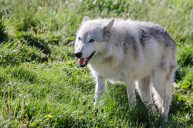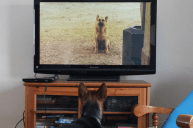There is a reason you cannot resist those puppy-dog eyes. Science tells us that for thousands of years people preferred the dogs that could pull off that look! Dogs use specific facial muscles that allow them to raise their eyebrows in a baby like position. This muscle is literally absent in their ancestor, the wolf.
AP News and The Atlantic report the results from a study published that looked at the special pair of muscles framing the eyes of both dogs and wolves,
"A paper published today in theProceedings of the National Academy of Sciences found that dogs' faces are structured for complex expression in a way that wolves' aren't, thanks to a special pair of muscles framing their eyes."
This evidence now shows that dogs evolved this pair of muscles to communicate and connect with humans better!
The New York Post says the researchers believe dogs used this muscle to communicate simple messages like "feed me",
"The researchers believe dogs, over their relatively short 33,000 years of domestication, used this eye muscle to communicate, possibly goading people to feed or care for them — or at least take them out to play. And people, perhaps unwittingly, obliged.
Dog experts not involved with the study were impressed."
Experts interviewed said that the muscles gave dogs an advantage when interacting with people and people have been unaware of it. This is probably not the same, but I'm always searching for a smile from my dogs when taking photos. I wonder if those muscles evolved too!
Anne Burrows of Duquesne University in Pittsburgh, an author of the study released by the Proceedings of the National Academy of Sciences said what also makes these findings so unique is that you don't typically see such muscle differences in species that are that closely related.
https://www.instagram.com/p/ByjOX50B_6X/
There are possibly some limitations to the study.
In the AP News story, Clive Wynne of the Canine Science Collaboratory at Arizona State University was interviewed and commented that this was a "a cool way to investigate an important aspect of dogs' success" with humans.
"He noted in an email that the study has a few snags, particularly the small sampling — only five dog breeds were examined and videos were mainly of Staffordshire bull terriers — and the lack of background information about each animal."
The importance of eye contact makes so much sense with this new study and why dogs make the facial expressions they do when they want to eat, go on a walk or even play!
Every day I get this look when our dog Sherm is ready for his dinner and I'm behind schedule. We hope they'll continue to do more of these studies with man's best friend.
Do you get those puppy-eyes from your dog? Tell us in the comments below!
Watch: 10 of the Smartest Dog Breeds




